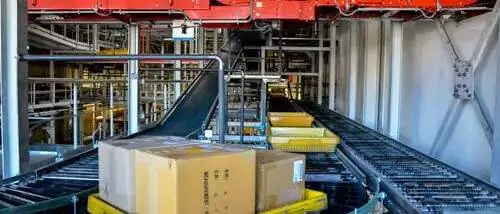Conveyor aids are used in intralogistics to combine individual goods into larger loading units. In general, the following definition applies: Intralogistics uses conveyor aids to protect different goods and make them ready for loading, transport, and storage.
In general, conveyor aids in intralogistics are components of the respective materials handling system. Components of such a materials handling system, which is intended exclusively for the transport of load units, are: conveyor aids, materials handling technology, and material flow control. Conveyor aids are generally used when a transported good cannot be conveyed in bulk or, as mentioned at the beginning, when smaller conveying quantities are bundled into large load units (1).
Conveyor aids are classified according to various criteria
- Non-load-bearing, non-rigid: shipping bags, nets, sacks, pouches, and bags
- Load-bearing: pallets
- Load-bearing, enclosing and dimensionally stable: Shelves, storage boxes, boxes, mesh boxes, barrels, canisters, cartons
- Load-bearing, enclosing and closing: Containers
- Special aids: Cords, tension belts, padding (styrofoam, air chamber material) and packaging films
Possible requirements for conveyor aids
They are often used under individual and difficult conditions. Contamination and industrial handling require material robustness for versatile use.
- High loading volume, low empty volume
- Ergonomic handling
- Precise fit on conveyor belts, pallet trucks / forklift trucks, storage and retrieval machines, overhead conveyors, cranes
- Adaptive use: container inserts, plug connections, partition walls
- Approval for hazardous goods
- Durability
- Recyclability
- Easy to use: filling, emptying, lifting, setting up
- Option of manual or automatic transport
- Resistance to oil, acid, and alkalis
- Easy to clean
- Suitable for extra logistics
Cardboard boxes, pallets, and the like as cost drivers
The “disadvantages” of using conveyor aids are less noteworthy, partly because their use is virtually unavoidable. However, these findings are at least taken into account in intralogistics warehouse planning. Auxiliary materials such as cartons or pallets must always be loaded and unloaded, and in large distribution centers with inventory management of thousands of article items, the high procurement costs must also be taken into account. An additional time-critical aspect is the transport of this type of auxiliary material or empty containers to the respective process sections where cartons, pallets, or mesh boxes are required, for example.
Summary
The auxiliary materials described above include pallets, containers, cardboard boxes, and shipping bags. They are divided into load-bearing, load-supporting, and non-load-bearing auxiliary materials. Conveyor aids are used to pick up and collect loose conveyed goods, which in turn speeds up logistics processes (storage, transport). They also protect the goods from damage and theft (visual protection).
(1) Timm Gudehus, Logistics, Fundamentals, Strategies, Applications, page 826, 3rd revised edition
(2) Graphic lernen.projekt-eloq / die Anforderungen
Further information on the subject of conveyor aids can also be found under Order picking robots and under Transport strategies in intralogistics.
